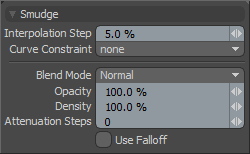The Smudge tool shift pixels from under the brush in the direction of the mouse or stylus' movement creating the visual effect of smearing the paint together. Users can select the tool from the 'Paint' interface tab under the 'Paint Tools' subtab of the toolbox. The 'Smudge' tool can also be activated from the menu bar option under the "Texture > Paint Tools" menu. When selected, the tool will also auto-select a Tip allowing users to begin painting directly into the active image map, defined by the image in the shader tree with the small paintbrush icon next to it (![]() ). Simply select a different target layer if you wish to paint onto a different layer. Users may also select different Tips and additionally add Ink and Nozzle effects to the paintbrush to further customize the way the brush applies to the surface. When selected, the associated attributes display in the Properties panel.
). Simply select a different target layer if you wish to paint onto a different layer. Users may also select different Tips and additionally add Ink and Nozzle effects to the paintbrush to further customize the way the brush applies to the surface. When selected, the associated attributes display in the Properties panel.
Smudge--
 Interpolation Step: Generally, paint strokes are not a continuous lines, but a series of dots or dabs placed on the image canvas. This option defines the distance between each dab as a percentage of the brush size. By default, this value is set to 5%. So for an 80 pixel sized brush, dabs would be placed every 4 pixels (5% of 80 = 4). Users can increase or reduce this value for a variety of effects. Increasing it toward 100% will produce individual dots, rather than what looks like a stroked line.
Interpolation Step: Generally, paint strokes are not a continuous lines, but a series of dots or dabs placed on the image canvas. This option defines the distance between each dab as a percentage of the brush size. By default, this value is set to 5%. So for an 80 pixel sized brush, dabs would be placed every 4 pixels (5% of 80 = 4). Users can increase or reduce this value for a variety of effects. Increasing it toward 100% will produce individual dots, rather than what looks like a stroked line.
Curve Constraint: The 'Curve Constraint' option allows users to use pre-drawn curves, either Spline or Bezier, and then constrain the brush strokes to the curve when painting, producing a very smooth, controlled and repeatable result. It works by having the curve element in the background layer (visible, but not selected). Then the 'Curve Constraint' option is set to either 'Background 2D' or 'Background 3D' mode. Once set any paint strokes into the canvas near the curve will constrain to the nearest curve position.
The 'None' option disables the constraining, the 'Background 2D' projects the curve from any orientation onto the surface through the viewport and the 'Background 3D' option constrains the stroke to the curves position in 3D space, only affecting surfaces that are within close proximity (defined by the brushes size).
Blend Mode: The Blend Mode defines how the strokes will blend into the existing canvas. The default 'Normal' setting will apply opaque strokes (as defined by the Opacity option) over the top of the existing canvas. The alternate options will work in the same respect as the layer blending options documented with examples on the Blend Modes page of the documentation.
Opacity: This value determines the transparency of the brush tip, in turn affecting how opaque the paint generated by the brush is. Values under 100% will reduce the transparency, attenuating down toward 0% where the pixels painted would be completely invisible.
Density: This value determines the amount of paint that comes out during a paint stroke. A value of 100% applies even pressure across the brush's tip, values under 100% attenuating down toward 0% gradually concentrate the paint toward the center of the brushes tip, producing a results that is similar, but different, than changing the opacity.
Attenuation Steps: This value will cause the paint to "fade out" after the set number of steps is reached in the stroke. This setting is somewhat related to the speed with which you create the stroke as painting quickly will spread out the "steps" used to paint the stroke. Moving the brush slowly with this value set above 0 will cause the paint to run out in a shorter stroke. This is a very useful setting to use if you do not have a tablet to paint with. Tablet users would be better suited to modulate the paint opacity based on the tablet pressure so as to have greater control.
Use Falloff: The 'Use Falloff' option will allow any of the various falloffs to mask the application of brush strokes. Since the RMB brush sizing function supersedes the RMB function to define the falloff, ensure the falloff is defined prior to activating the tool.


